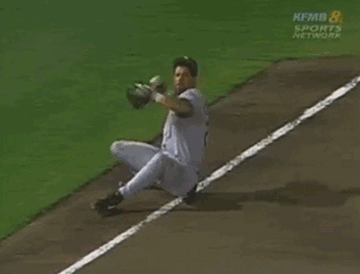This is one of the best clips I’ve seen that really shows the separation of links between the hips and trunk during a throw. This is what High Level Throwing is all about! The clip shows Ken Caminiti, a former Major League Third Baseman, throwing from a seated position.

Glute Function
Ken Caminiti is sitting on the ground before he is about to throw this ball to first base. As the glute musculature is activated, the hips will extend, bringing his body off the ground. There’s definitely a bit of back leg push-off which helps this hip extension pattern to occur.
Remember that the glute muscle, when activated or squeezed, extends the hips. When throwing, the hips will move from flexion into extension by the activation of the rear glute musculature. This also helps the Hip to Trunk Relationship which helps with velocity.
Back Leg Movement
As the hips become extended, there is back leg femoral movement. The hips are opening up while the trunk is still closed and turned back against the hips. The femur is internally rotating in the acetabulum (hip socket) as the trunk turns back against the hips. As you can see, he is sitting down and throwing this ball, so there is no formal stride pattern.
The right knee is already flexed (bent), so the knee cannot be initiating the back leg movement as so many pitching coaches instruct. The femur is actually moving in the hip joint as it would in a normal step and throw movement.
Hip & Trunk Movement
As mentioned above, the hips are opening up as the trunk is turned back against the hips. The trunk also maintains that “turn” until the arm moves through its necessary pattern. This is how resistance is created! You can also see that the hips are moving into extension, from glute activation, which is also how velocity is created.
As the arm moves through its proper pattern into and through external rotation, the hips are opening up and the trunk is turning or already is turned back against those opening hips. The trunk will then release in the Transverse Plane and fire towards the target, bringing the arm forward to ball release.

Creation of Resistance
In order to create velocity, you must create resistance in a throw! The clip above shows exactly how resistance is created between the hips and trunk and the sequential summation of movements (big movements followed by smaller movements) happening. These overlapping movements must happen in order to maximize throwing potential!
Leave a Reply